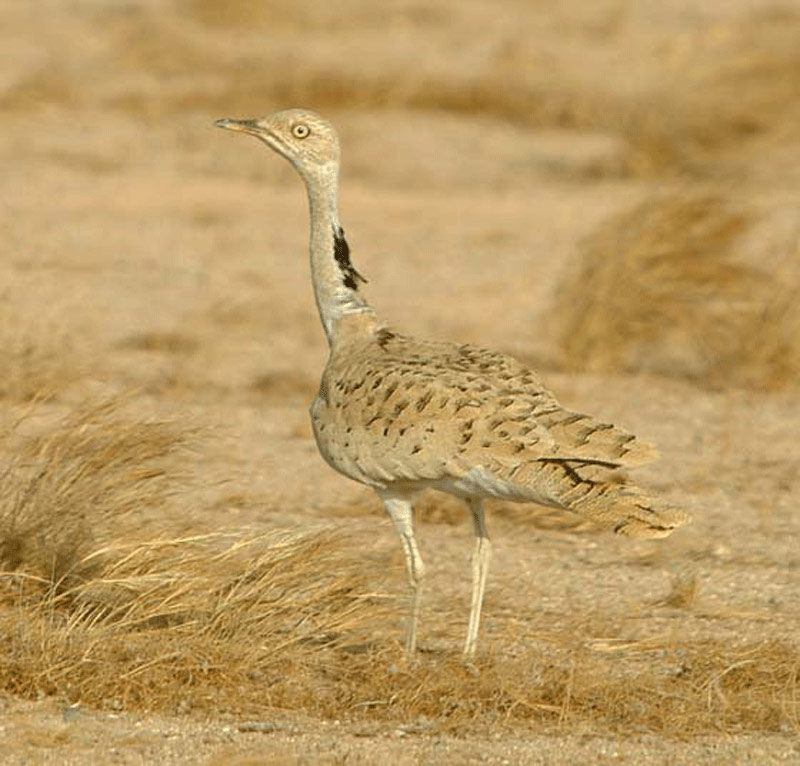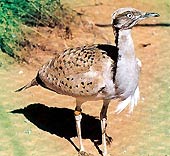 |  |

This migratory bird arrives every year in Pakistan in November and December from Mongolia, Siberia and central Asian republics. According to a study, its population is rapidly declining in Afghanistan, Pakistan, Iran, India, UAE and Middle East countries.
The Asian Houbara could be extinct within 15 to 25 years if unchecked hunting, illegal trapping and trading of the bird continued at the existing scale, said the study conducted by the Environment Research and Wild life Development Agency (ERWDA). ERWDA estimated that the natural death rate of the bird was 3.28 percent while death due to hunting accounted for more than 73 percent. The rate of hunting has reached nearly 20.8 percent, dangerously exceeding the acceptable 7.2 percent.
Because of the increased hunting of the bird, especially in its winter habitats, the Convention on the International Trade in Endangered Species (CITES) has classified it as an endangered migratory bird. The Houbara Bustard is also listed in the Convention on Migratory Species of Wild Animals, which is known as the Bonn Convention. The World Conservation Union has put it in the ‘Near Threatened’ category.
“If the present situation continues, the number of these birds will be reduced by 50 percent by 2015 and they could be extinct by 2027,” the study said. “There is a gradual decrease in the number of Houbara birds coming to Pakistan each year,” Dr Mumtaz Malik, the chief conservator Wildlife, NWFP, said.
Rivalry between the Houbara’s newborns is also one of the factors in their decrease, he said. “The Houbara gives birth to only two offspring a year but the elder one kills the younger sibling due to the fear of having to share food,” Dr Mumtaz said. According to Dr Mumtaz, the enthusiasm of NGOs interested in preserving the endangered species has been on the decline.
Lt Col Shams Ernest, spokesman of the Houbara Bustard International Foundation (HBIF), Lahore, said that all arid areas in Punjab, Sindh and Balochistan were the Houbara’s winter habitat.
“The bird is being artificial bred in the UAE, Saudi Arabia and Morocco. But it has to be done under extremely controlled conditions and is very expensive,” he said. This desert bird migrates to Pakistan in winter and leaves in April and May, said Yar Muhammad Khan, a former official of NWFP Wildlife, Fisheries and Forests Department. Covering a distance of about 4,500 to 5,000 kilometres, the Houbara journeys from central Asia and Siberia at altitudes of 300 to 500 feet and lands in Bahawalpur, Rahimyar Khan and the arid areas of Sindh and Balochistan, Khan said. The bird eats flora, insects and earthworms. “The Houbara is very sensitive and does not use the same route again if it senses any danger on its way during the first journey. If the Houbara looses its mate, it takes three to five years to find a new one,” Khan said. The bird travels in groups with one chief. If they loose their chief, the deputy guides the group to its destination. “Approximately 500 to 2,000 Houbara are trapped each year with the help of falcons, nets and other means in the arid areas of Sindh, Punjab and Balochistan. If the hunting continued, the Houbara population will vanish in a decade or so,” Khan said.
Dr Mumtaz recommended community involvement through financial and other incentives in preservation and protection of the Houbara Bustard. app.